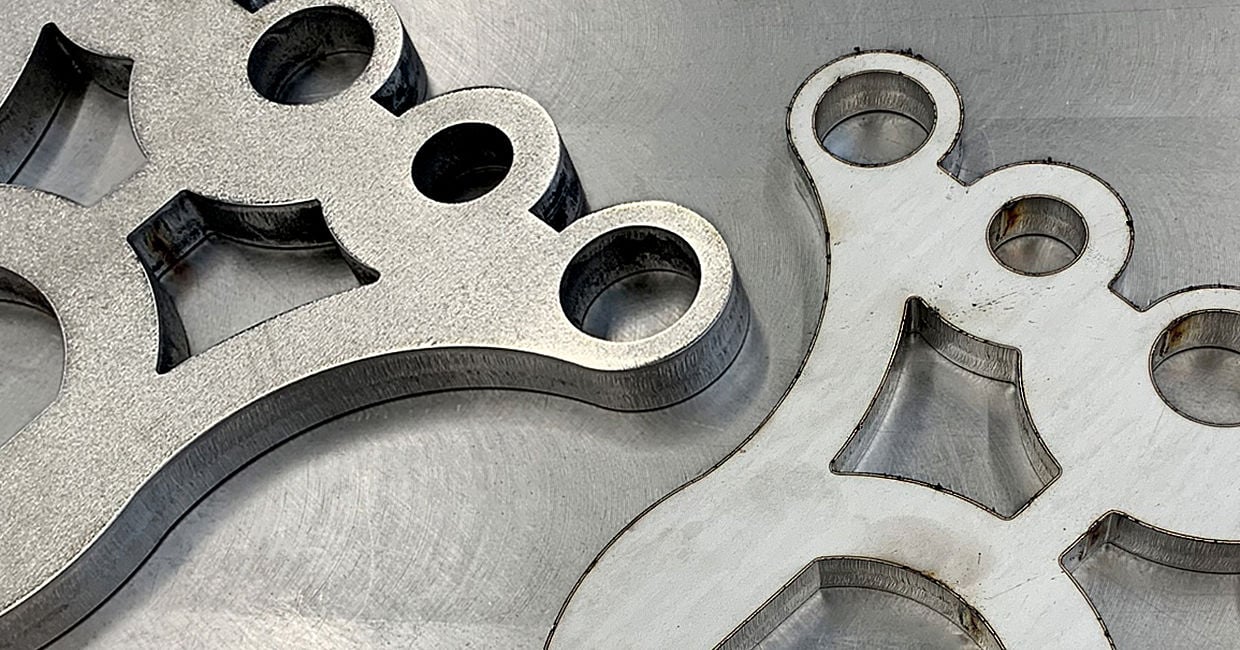As little as possible and as much as necessary.
When it comes to the protection of your downstream equipment, the absence of burrs is a must. Some of these machines can include press brakes, bending and leveling machines. Before any materials can be bent or leveled, they should be free of any burrs. Rounding is not necessary, as the leveling rollers can only be damaged or worn by raised burrs. This burr-free condition is also necessary for parts that will be machined later on. Turning and milling tools can be damaged by burrs in a similar fashion.
When it comes to avoiding cutting injuries for employees, experience shows that 1/10 mm (0.005”) edge rounding is sufficient. Even a latex glove, pneumatic hose or cable that comes in contact with the edge, should not be damaged even if the edge rounding is in the range of 1/10 mm (0.005”).
Real life example
A mechanical engineering company received complaints because pneumatic hoses were damaged due to them rubbing against burrs and sharp edges inside their sheet metal fixture. After conducting market research, they had found that there are deburring machines available capable of providing a 0.7 mm (0.03”) radius on 6 mm (0.24”) thick sheet metal parts. Since then, the part drawings now contain exactly this information without ever having checked which rounding is technically really necessary.
Unfortunately, reality shows that such drawing specifications are rarely ever “taken back”. This can become complex and expensive due to the unnecessarily high removal costs. Therefore, a practical test provides information about the real requirements for the edge and if it is even necessary to be performed.
Click here to learn more about our Toll Processing services.
It becomes much more complex when it comes to preparing the materials for powder coating. The influencing factors are multi-layered. Starting with the type of coating (cathodic dip painting, powder, wet paint), the type and quality of the painted material, the system parameters such as pre-treatment, drying time or baking temperature, and the final placement of the product. Together with the edge radius, these influencing factors are also decisive for the durability of the corrosion protection.
Ultimately, trials must be conducted to test to which degree of corrosion protection can be achieved via a specific rounding. All other influencing factors must then remain unchanged during these tests.
Reliable coating from edge rounding of 0.5 mm (0.02”).
The “neutral salt spray test NSS according to DIN EN ISO 9227:2017” is usually used as a method for testing corrosion protection. The course of corrosion is considered over time (often in comparison with several other samples). In addition, cross sections can be made to make visible how much the thickness of the coating changes in order to measure the rounding of the sample (if necessary afterwards). These samples also show that the shape of the radius has an influence on the coating thickness. In the case of asymmetrical rounding, the layer thickness decreases at the point with the strongest curvature. It can therefore be assumed that a uniform radius is the ideal form of edge rounding.
Standards have been derived from these findings (e.g. for steel construction), which require a radii of 2.0 mm (0.08”) and more on the edges for certain components. Nevertheless, numerous practical applications have shown that good paint adhesion is often achieved with a rounding of just 0.5 mm (0.02”) on the sheet metal edge. Since the removal rate and the consumable costs increase proportionately with increasing edge radius, it is important for the user to find the right setting for a reliable and at the same time economical rounding result. All coming back to the same point as above; as little as possible and as much as necessary.
How much edge rounding does your sheet metal need?
Trials and deburring on a toll processing basis – all quickly and readily available in the ARKU Leveling and Deburring Center. Contact our experts for any questions you might have about deburring and edge rounding your sheet metal.
Click here to learn more about the Leveling and Deburring Center.



